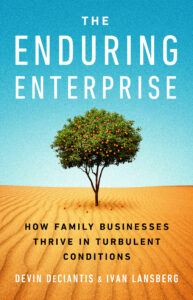The second-generation CEO of a large family enterprise was approached by a strategic investor who made a generous and unsolicited offer for their legacy operating business. The CEO had previously never explored a sale because of her strong emotional connection to the company and its employees — two of whom were her kids — and because of its attractive cash flow and growth profile. However, this offer was difficult to ignore, given that it was nearly double their most recent private valuation.
When faced with a strategic dilemma, the CEO often reached out to a few of her peers to ask how they had dealt with similar situations. Several of the family leaders she spoke with chose to sell their legacy business and then set up a Family Office to redeploy most of the wealth — though often not without some sellers’ remorse. Others chose to continue operating their legacy business — though often not without regret at the missed opportunity to exit at an attractive multiple. However, the most interesting and thoughtful response came from a close friend who led a Single Family Office and shared his more patient and inclusive approach.
When first approached by a potential buyer, he immediately asked the family’s continuity advisor, a Partner at LGA, to help him design a process to gather the family’s aspirations for the future and ensure that all of the family members fully understood the many benefits and risks of either selling or holding onto their legacy business. That process of Strategic Alignment involved a series of interviews and structured conversations with the family to answer one critical question that would define how the Chair and the Board would proceed: Why should we stay together as owners of this collective enterprise?
During this process, the family articulated some deep reservations about selling the legacy business, which was founded by the family patriarch three generations ago. However, they also acknowledged that over that time, the family business had pivoted many times in response to prevailing conditions, shifting industries and geographies in response to evolving opportunities and risks.
At the end of the month-long process, the family converged on a new shared vision — transitioning from being a “family enterprise” to becoming an “enterprising family.” Instead of being tethered to a single asset or business, they would collectively steward a network of assets and activities that allowed each family member to live a fulfilled life while also providing opportunities to collaborate and have a positive impact in the world. They also were clear that any buyer would need to preserve the unique culture of their legacy business and commit to supporting their employees, customers, and communities for the foreseeable future.
With the clarity provided by this new shared vision, the Chair and the Board negotiated a sale of the business, then redeployed the proceeds by setting up a Family Office and a Family Foundation, along with a new governance structure to coordinate these activities. They would also invest in the development of the family’s human capital and leadership potential and provide each family member with a special dividend to help them diversify some of their wealth outside the family enterprise.
The CEO appreciated the patient, inclusive and principled nature of this approach. She immediately invited LGA to help her family achieve its own Strategic Alignment before making what was likely the most important decision in the history of their family enterprise.





